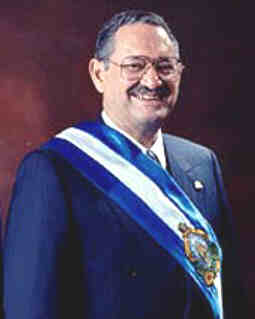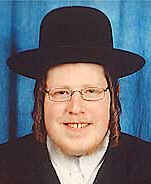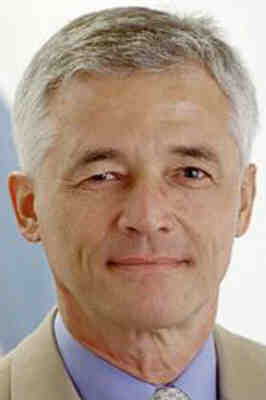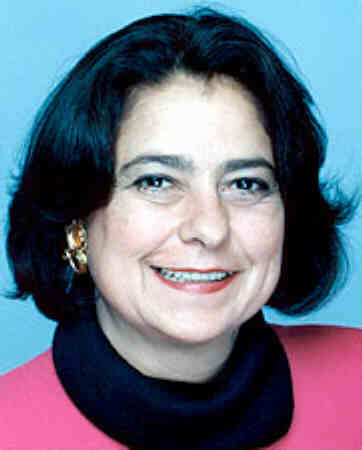Births
which occurred on a 19 August:
2003 Giant
Panda, at the San
Diego Zoo, to Bai Yun, 13, on loan from China. The newborn “giant”
is about 10cm long. Its twin is stillborn two days later. Bai Yun gave birth
before: to Hua Mei, on 21 August 1999.
1946 Bill Clinton,
42nd US President (Democrat), 2nd one to be impeached and not convicted.
(Former Little Rock attorney, Arkansas governor)
1939 Alan
Baker, English mathematician
1919 Malcolm Forbes,
Sr. (publishing magnate: Forbes magazine), candidate for Republican presidential
nomination (1996)
1915 Ring Lardner (writer: You
Know Me, Haircut and Other Stories)
^
1906 Philo Farnsworth, in Beaver, Utah,
television pioneer
Philo T. Farnsworth
would grow up to imagine the principles of television during high
school and later begin researching image transmission at Brigham Young
University. In 1927 he would transmit the first television image-ironically,
a dollar sign-made up of 60 horizontal lines. He went on to patent
165 devices pertaining to the television, including cathode ray tubes,
amplifiers, vacuum tubes, and electrical scanners. He cofounded Crocker
Research Labs in 1926, which became Farnsworth Television Inc. in
1929, and later Farnsworth Radio and TV Corporation. |
1903 James Gould Cozzens US, 1949-(Pulitzer Prize-winning
novelist: Guard of Honor [1948]; S.S. San Pedro, The Last Adam, By Love
Possessed)
1902 Ogden Nash Rye NY, humorous poet
(I'm a Stranger Here Myself)
1899 Bradley Walker Tomlin,
US artist who died in 1953.
1886 The Christian Union
is founded by Baptist clergyman Richard G. Spurling (1858-1935) in Monroe
County, Tennessee. In 1923, this pentecostal denomination changed its name
to the Church of God. Headquartered today in Cleveland, Tennessee, its current
membership is nearly 500'000.
1883 Coco (Gabrielle) Chanel
(fashion designer; perfume creator: Chanel #5)
1881 Georges
Enesco (or Enescu) Romania, composer (Romanian Dances)
1878 Manuel Quezon first president of Philippine Commonwealth (1935-42)
1871 Orville Wright (one of the Wright Brothers:
pioneers in aviation)
1870 Bernard Baruch financier/presidential
adviser (financier; chairman of War Industries Board [WWI]; US representative
to UN Atomic Energy Commission; presidential adviser)
1860
John Kane Scottish-born US primitivist painter (Self-Portrait)
1848 Gustave Caillebote, French artist who died
on 21 February 1894. — MORE
ON CAILLEBOTE AT ART “4” AUGUST
with links to images.
1844 Minna Canth Finland,
novelist/dramatist (social evils)
1829 Edward Moran,
US painter who died on 09 June 1901 — MORE
ON MORAN AT ART “4” AUGUST
with links to images.
1808 Petrus Jan Schotel, Dutch
artist who died on 23 July 1865.
1805 Josef Dankhauser,
Austrian artist who died on 04 May 1845. — MORE
ON DANHAUSER AT ART “4” AUGUST
with links to images.
1785 Seth Thomas pioneer in
mass production of clocks
1739 Georg
Simon Klügel, German mathematician who died on 04 August
1812.
1736 Erland
Samuel Bring, Swedish mathematician who died on 20 May 1798.
Author of Meletemata quaedam mathematematica circa transformationem
aequationum algebraicarum (1786).
1689 Samuel Richardson
English novelist (Pamela) (baptized)
1646 John
Flamsteed, English astronomer who died on 31 December 1719.
He published accurate astronomical observations and was the first Astronomer
Royal.
^
1631 (09 August Julian) John Dryden,
English poet, dramatist, and literary critic, who died on 12 May (01
May Julian) 1700.
Dryden so dominated
the literary scene of his day that it came to be known as the Age
of Dryden. He was the first official Poet Laureate of Great Britain
(1668 to1700).
The son of a country
gentleman, Dryden grew up in the country. When he was 11 years old
theCivil War broke out. Both his father's and mother's families sided
with Parliament against the king, but Dryden's own sympathies then
are unknown.
About 1644 Dryden
was admitted to Westminster School, where he received a predominantly
classical education under the celebrated Richard Busby. His easy and
lifelong familiarity with classical literature begun at Westminster
later resulted in idiomatic English translations.
In 1650 he entered Trinity College, Cambridge, where he took his B.A.
degree in 1654. What Dryden did between leaving the university in
1654 and the Restoration of Charles II in 1660 isnot known with certainty.
In 1659 his contribution to a memorial volume for Oliver Cromwell
marked him as a poet worth watching. His “heroic stanzas” were mature,
considered, sonorous,and sprinkled with those classical and scientific
allusions that characterized his later verse. This kind of public
poetry was always one of the things Dryden did best.
When in May 1660 Charles II was restored to the throne, Dryden joined
the poets of the day in welcoming him, publishing in June Astraea
Redux, a poem of more than 300 lines in rhymed couplets. For
the coronation in 1661, he wrote To His Sacred Majesty. These
two poems were designed to dignify and strengthen the monarchy and
to invest the young monarch with an aura of majesty, permanence, and
even divinity. Thereafter Dryden's literary productivity was remarkable
and his touch almost invariably confident and sure. On 11 December
1663, he married Elizabeth Howard, the youngest daughter of Thomas
Howard, 1st earl of Berkshire. In due course she bore him three sons.
Dryden's longest poem to date,
Annus Mirabilis (1667), was a celebration of two victories
by the English fleet over the Dutch and the Londoners' survival of
the Great Fire of 1666. In this work Dryden was once again gilding
the royal image and reinforcing the concept of a loyal nation united
under the best of kings. It was hardly surprising that when the poet
laureate, Sir William Davenant, died in 1668, Dryden was appointed
poet laureate in his place and two years later was appointed royal
historiographer.
Soon after his
restoration to the throne in 1660, Charles II granted two patents
for theatres, which had been closed by the Puritans in 1642. Dryden
soon joined the little band of dramatists who were writing new plays
for the revived English theatre. His first play, The Wild Gallant,
a farcical comedy with some strokes of humour and a good deal of licentious
dialogue,was produced in 1663. It was a comparative failure, but in
January 1664 he had some share in the success of The Indian Queen,
a heroic tragedy in rhymed couplets in which he had collaborated with
Sir Robert Howard. Dryden was soon to successfully exploit this new
and popular genre, with its conflicts between love and honour and
its lovely heroines before whosecharms the blustering heroes sank
down in awed submission. In the spring of 1665 Dryden had his own
first outstanding success with The Indian Emperour, a play
that was a sequel to The Indian Queen.
In 1667 Dryden had another success with a tragicomedy, Secret
Love, or the Maiden Queen, which appealed particularly to the
king. The part of Florimel, a gay and witty maid of honor, was played
to perfection by the king's latest mistress, Nell Gwynn. In Florimel's
rattling exchanges with Celadon, the Restoration aptitude for witty
repartee reached a new level of accomplishment. In 1667 Dryden also
reworked for the stage Molière's comedy L'Étourdi (translated
by William Cavendish, duke of Newcastle) under the title Sir Martin
Mar-all.
In 1668 Dryden published
Of Dramatick Poesie, an Essay, a leisurely discussion between
four contemporary writers of whom Dryden (as Neander) is one. This
work is a defense of English drama against the champions of both ancient
Classical drama and the Neoclassical French theatre; it is also an
attempt to discover general principles of dramatic criticism. By deploying
his disputants so as to break down the conventional oppositions of
ancient and modern, Frenchand English, Elizabethan and Restoration,
Dryden deepens and complicates the discussion. This is the first substantial
piece of modern dramatic criticism; it is sensible, judicious, and
exploratory and combines general principles and analysis in a gracefully
informal style. Dryden's approach in this and all his best criticism
is characteristically speculative and shows the influence of detached
scientific inquiry.
In 1668 Dryden
agreed to write exclusively for Thomas Killigrew's company at the
rate of three plays a year and became a shareholder entitled to one-tenth
of the profits. Although Dryden averaged only a play a year, the contract
apparently was mutually profitable. In June 1669 he gave the company
Tyrannick Love, with its blustering and blaspheming hero
Maximin. In December of the next year came the first part of The
Conquest of Granada by the Spaniards, followed by the second
part about a month later. All three plays were highly successful;
and in the character Almanzor, the intrepid hero of The Conquest
of Granada, the theme of love and honor reached its climax. But
the vein had now been almost worked out, as seen in the 1671 production
of that witty burlesque of heroic drama The Rehearsal, by
George Villiers, 2nd duke of Buckingham, in which Dryden (Mr. Bayes)
was the main satirical victim. The Rehearsal did not kill the heroic
play, however; as late as November 1675, Dryden staged his last and
most intelligent example of the genre, Aureng-Zebe. In this
play he abandoned the use of rhymed couplets for that of blank verse.
In writing those heroic plays, Dryden
had been catering to an audience that was prepared to be stunned into
admiration by drums and trumpets, rant and extravagance, stage battles,
rich costumes, and exotic scenes. His abandonment of crowd-pleasing
rant and bombast was symbolized in 1672 with his brilliant comedy
Marriage à-la-Mode, in which the Restoration battle
of the sexes was given a sophisticated and civilized expression that
only Sir George Etherege and William Congreve at their best would
equal. Equally fine in a different mode was his tragedy All for
Love (1677), based on Antony and Cleopatra of Shakespeare
and written in a flowing but controlled blank verse. Dryden had now
entered what may be called his Neoclassical period, and, if his new
tragedy was not without some echoes of the old extravagance, it was
admirably constructed, with the action developing naturally from situation
and character.
By 1678 Dryden
was at loggerheads with his fellow shareholders in the Killigrew company,
which was in grave difficulties owing to mismanagement. Dryden offered
his tragedy Oedipus, a collaboration with Nathaniel Lee,
to a rival theatre company and ceased to be a Killigrew shareholder.
Since the publication of Annus Mirabilis
12 years earlier, Dryden had given almost all his time to playwriting.
If he had died in 1680, it is as a dramatist that he would be chiefly
remembered. Now, in the short space of two years, he was to make his
name as the greatest verse satirist that England had so far produced.
In 1681 the king's difficulties, arising from political misgivings
that his brother, James, the Roman Catholic duke of York, might succeed
him, had come to a head. Led by the earl of Shaftesbury, the Whig
Party leaders had used the Popish Plot to try to exclude James in
favor of Charles's illegitimate Protestant son, the duke of Monmouth.
But the king's shrewd maneuvers eventually turned public opinion against
the Whigs, and Shaftesbury was imprisoned on a charge of high treason.
As poet laureate in those critical
months Dryden could not stand aside, and in November 1681he came to
the support of the king with his Absalom and Achitophel,
so drawing upon himself the wrath of the Whigs. Adopting as his framework
the Old Testament story of King David (Charles II), his favorite son
Absalom (Monmouth), and the false Achitophel (Shaftesbury), who persuaded
Absalom to revolt against his father, Dryden gave a satirical version
of the events of the past few years as seen from the point of view
of the king and his Tory ministers and yet succeeded in maintaining
the heroic tone suitable to the king and to the seriousness of the
political situation. As anti-Whig propaganda, ridiculing their leaders
in a succession of ludicrous satirical portraits, Dryden's poem is
a masterpiece of confident denunciation; as pro-Tory propaganda it
is equally remarkable for its serene and persuasive affirmation. When
a London grand jury refused to indict Shaftesbury for treason, his
fellow Whigs voted him a medal. In response Dryden published early
in 1682 The Medall, a work full of unsparing invective against
the Whigs, prefaced by a vigorous and plainspoken prose “Epistle to
the Whigs.” In the same year, anonymously and apparently without Dryden's
authority, there also appeared in print his famous extended lampoon,
Mac Flecknoe, written about four years earlier. What triggered
this devastating attack on the Whig playwright Thomas Shadwell has
never been satisfactorily explained; all that can be said is that
in Mac Flecknoe Shadwell's abilities as a literary artist
and critic are ridiculed so ludicrously and with such good-humouredcontempt
that his reputation has suffered ever since. The basis of the satire,
which represents Shadwell as a literary dunce, is the disagreement
between him and Dryden over the quality ofBen Jonson's wit. Dryden
thinks Jonson deficient in this quality, while Shadwell regards the
Elizabethan playwright with uncritical reverence. This hilarious comic
lampoon was both the first English mock-heroic poem and the immediate
ancestor of The Dunciad of Alexander Pope [21 May 1688 –
30 May 1744].
In 1685, after the newly acceded king James II seemed to be moving
to Catholic toleration, Dryden was received into the Roman Catholic
church. In his longest poem, the beast fable The Hind and the
Panther (1687), he argued the case for his adopted church against
the Church of England and the sects. The abdication of James II in
1688 destroyed Dryden's political prospects, and he lost his laureateship
to Shadwell. He turned to the theater again. The tragedy Don Sebastian
(1689) failed, but Amphitryon (1690) succeeded, helped by
the music of Henry Purcell. Dryden collaborated with Purcell in a
dramatic opera, King Arthur (1691), which succeeded. His
tragedyCleomenes was long refused a license because of what was thought
to be the politically dangerous material in it, and with the failure
of the tragicomedy Love Triumphant in 1694, Dryden stopped
writing for the stage.
In the 1680s
and '90s Dryden supervised poetical miscellanies and translated the
works of Juvenal and Persius for the publisher Jacob Tonson with success.
In 1692 he published Eleonora, a long memorial poem commissioned
for a handsome fee by the husband of the Countess of Abingdon. But
his great late work was his translation of Virgil, contracted by Tonson
in 1694 and published in 1697. Dryden was now the grand old man of
English letters and was often seen at Will's Coffee-House chatting
with younger writers. His last work for Tonson was Fables Ancient
and Modern (1700), which were mainly verse adaptations from the
works of Ovid, Geoffrey Chaucer, and Giovanni Boccaccio, introduced
with a critical preface. He died in 1700 and was buried in Westminster
Abbey between Chaucer and Abraham Cowley in the Poets' Corner.
Besides being the greatest English
poet of the later 17th century, Dryden wrote almost 30 tragedies,
comedies, and dramatic operas. He also made a valuable contribution
in his commentaries on poetry and drama, which are sufficiently extensive
and original to entitle him to be considered, in the words of Dr.
Samuel Johnson, as “the father of English criticism.”
After Dryden's death his reputation remained high for the next 100
years, and even in the Romantic period the reaction against him was
never so great as that against Alexander Pope. In the 20th century
there was a notable revival of interest in his poems, plays, and criticism,
and much scholarly work was done on them. In the late 20th century
his reputation stood almost as high as at any time since his death.
DRYDEN ONLINE: |
| Absalom
and Achitophel
All
for Love
All
for Love (another site)
All
for Love (a 3rd site)
Discourses on Satire and on Epic Poetry
Mac Flecknoe
The Medal: A Satire Against Sedition
Of
Dramatic Poesie
Palamon and Arcite |
Translations by Dryden:
|
1621 Gerbrand van den Eeckhout, Dutch biblical, genre,
and portrait painter, who died on 29 September 1674. — MORE
ON VAN DEN EECKHOUT AT ART “4” AUGUST
with links to images.
1584 Pierre
Vernier, Ornans, Franche-Comté (then under the Spanish
Habsburgs), government official, engineer, surveyor, mathematician, who
died on 14 September 1638. Author of La Construction, l'usage, et les
propriétés du quadrant nouveau de mathématiques (1631), in which he
gives a table of sines and a method for deriving the angles of a triangle
if its sides are known. He also describes his most famous invention, that
of the vernier caliper.
1398 Iñigo López
Spain, marques de Santillana, poet (Comedieta de Ponza)
|
 Deaths
which occurred on an 19 August:
Deaths
which occurred on an 19 August:

 2003
The following 16 UN staff members:
2003
The following 16 UN staff members: 
